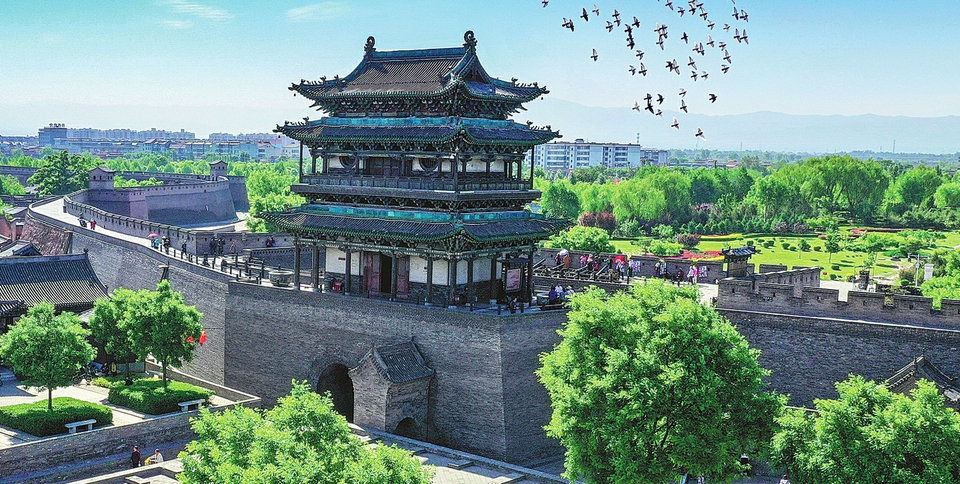
+86-351-4034948
service@wsb.shanxi.gov.cn

Hundreds of buildings dating back centuries draw millions of tourists to Pingyao in Shanxi

The 6-kilometer-long city wall is the most spectacular structure in the ancient city of Pingyao. Liang Shengren / For China Daily
In today's China, where cities are dominated by modern high-rise buildings, it is rare to find an ancient city or town like Pingyao.
The city of Pingyao in Jinzhong, Shanxi province, is said to have one of best-preserved historical townscapes in China. It looks much the same as it did during the Ming (1368-1644) and Qing (1644-1911) dynasties.
The ancient city of Pingyao, established in 1368, is a prototype of Chinese cities and an excellent example with which to explore the socioeconomic system of late imperial China.
Its prosperity in history was associated with the renowned Shanxi merchants, or Jinshang, in Ming and Qing dynasties.
It is said that Jinshang merchants dominated commercial circles in North China for about 500 years starting from the Ming Dynasty.
Many of these successful merchants began as small vendors selling products like tea and silk to overseas regions. Over generations, they made their fortunes through hard work.
Pingyao was then a renowned commercial hub and financial center supporting the Jinshang merchants' business. It was also a large residential community for businesspeople.
To this day, Pingyao is home to nearly 4,000 ancient buildings.
Surrounding these buildings and streets is a 6-kilometer-long city wall, which is said to have been built in 1370.
For its large number of ancient buildings and rich historical and cultural heritage, Pingyao was designated a UNESCO World Cultural Heritage Site in 1997. This recognition has helped the city develop into a famed domestic and international tourism destination.
The city is home to more than 10,000 residents, who benefit from and take pride in Pingyao's status as one of the top tourist destinations in Shanxi.
Realizing that the rich historical and cultural heritage is the soul of the city, many residents said they are willing to protect this ancient city as they protect their own lives.
Jia Weiping, 62, is a native of Pingyao and a remarkable figure among tourists. He is the actor of an old-time county magistrate in a theatrical performance staged regularly in front of the Pingyao Old County Government Museum.
Jia said the most spectacular structure of Pingyao is the ancient city wall. "The city wall has 72 watchtowers in its length of 6 km," Jia said. "The number is of great cultural significance as it represents the 72 famed disciples of Confucius."
He said another cultural highlight of Pingyao is the Kuixing Pavilion built on the southeast section of the wall. In Chinese mythology, Kuixing is a constellation governed by a deity in charge of culture and education.
He said that protection of the ancient city wall was challenged several decades ago. "In the 1970s, the city wall was almost in a state of dilapidation," Jia said. "Among the 72 watchtowers, there were only three left intact."
He said people back then lacked the awareness of historical heritage preservation. "People would pull out the bricks of the wall to repair their own houses," Jia said. The city wall is a structure of rammed earth, covered by bricks on its exterior.
Jia's account of the past was agreed by Wang Guohe, a retired urban planning official in Pingyao.
"We met an even greater challenger in the 1980s when there was a trend throughout the country to tear down old buildings and build new ones for urban development," Wang, 73, recalled.
Fortunately, the local planners were among the more sober-minded who knew the importance of preserving historical and cultural heritage.
"Bucking that trend of modernization, we were among the first in the country to have a plan to preserve and protect the ancient city," Wang said.
The preservation plan started by repairing the city wall. Officials called on residents to return the wall's original bricks to complete the repair.
"We told residents that Pingyao was among the very few cities in China that had a complete city wall," Wang said. "This was something they should take pride in."
They added that a well-preserved ancient city would be beneficial to them, as it could draw in tourists and help to increase revenue.
"The response from residents was overwhelming at the time," Wang said. "They returned more than 10,000 bricks in two months."
The preservation of Pingyao also attracted the attention of the country's top experts in planning and heritage protection, according to Wang. "They came to Pingyao to conduct field research and proposed plans for protection."
The protection program led to Pingyao's fame as one of the nation's best-preserved ancient cities and it became recognized throughout China. In 1986, it was rated as a national-level historical and cultural city. By 1988, the ancient city wall was included in the national list for cultural heritage protection.
The renovation and repair project of the whole city was completed in 1993. Four years later, it made the list of UNESCO World Heritage sites.
"We have seen a rapidly growing number of tourists since 1997," Jia said, citing local statistics. "There were only 50,000 visits in 1997 and the number was more than 17.65 million in the peak year of 2019."
Peng Ke’er contributed to this story.
By Yuan Shenggao